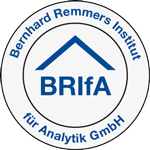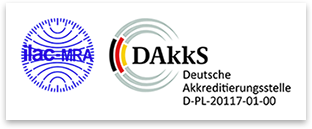






Microscopic analyses are used by BRIfA mainly in four areas. These are the determination of the fungi that cause mould and house-decay, asbestos and artificial mineral fibres. In addition the layer thickness of paints and coating materials can be examined on the microscope.
It happens often that in interiors dark stains appear on tapestry or other surfaces. There are several causes that might be responsible, such as a fogging effect or the growth of mould fungi on the surface. To determine what the cause is in a concrete instance, an examination under the microscope is necessary. The fungal spores of mould are found practically everywhere. While they can survive a long time under unfavourable conditions, they start to grow when the surrounding environment is right. In particular this requires the presence of a certain level of moisture inside the building material or on its surface. The required water content varies on the type of fungus and must be available for a sufficiently extended period of time. The growth of mould fungi is determined by essentially three factors: humidity, availability of nutrients and temperature. High levels of moisture in buildings can be caused by insufficient drying after building measures, incorrect heating and ventilation, especially in air tight buildings, as well as condensation.
Wood destroying fungi can cause considerable damage in buildings by causing the wood to rot. This rot can damage wood structures and severely impair their mechanical properties. The most often encountered wood destroying fungi include Serpula lacrymans which causes dry rot, Coniophora puteana and Donkioporia expansa. For a correct planning of restoration measures it is essential to identify the exact species that caused the damage to be reapired.
Asbestos is naturally occurring, fibrous silicate mineral. The use of asbestos and asbestos-based formulations has been banned in Germany since 1993. Materials that contain as little as 0.1% of asbestos are hazardous substances classified as category 1 carcinogens. To assess the level of risk involved with the use of asbestos-containing material, the German Technical Rules for Hazardous Substances, TRGS 519, the determination of the type of the asbestos, the des content of asbestos fibres in the material and determination of the density of the material itself, in which the asbestos is contained.
Identification of moulds
Packaging and labelling of the sample
Important information/photo documentation
Scanning electron microscope examination for the identification of asbestos in building materials
Samples size, quantity and quality
Take appropriate measures to avoid the inhalation of asbestos or artificial mineral fibres that might be released into the ait during sampling!




Identification of wood-decay fungi
Packaging and labelling of the sample
Important information/photo documentation
For further information, please see the detailed Service Overview Microscopic Examination (PDF).
© Bernhard Remmers Institut für Analytik • Bernhard-Remmers-Str. 13 • 49624 Löningen • Fon: 054 32 / 83-569 • Fax: 054 32 / 83-767 • info@brifa.de • www.brifa.de